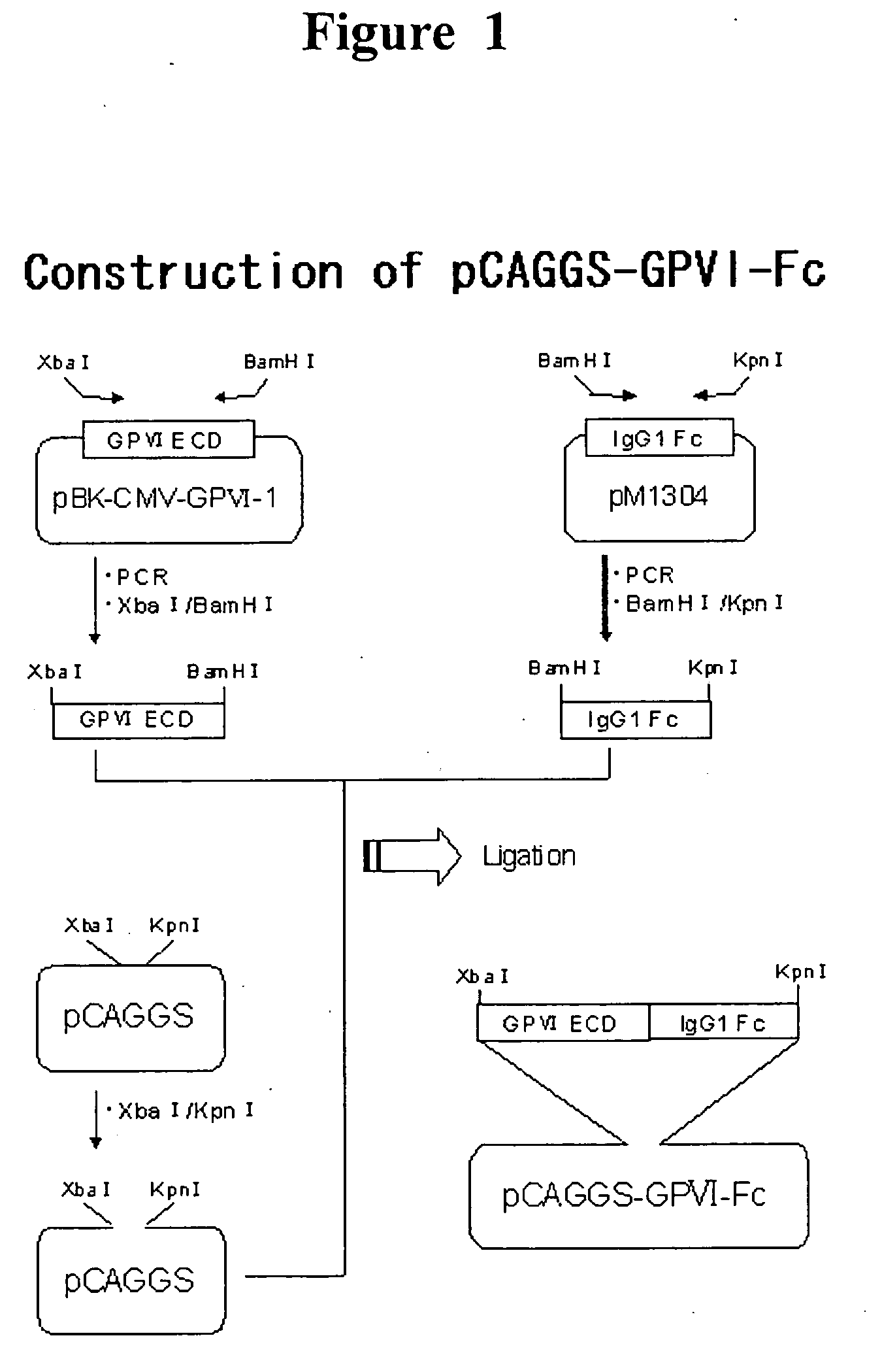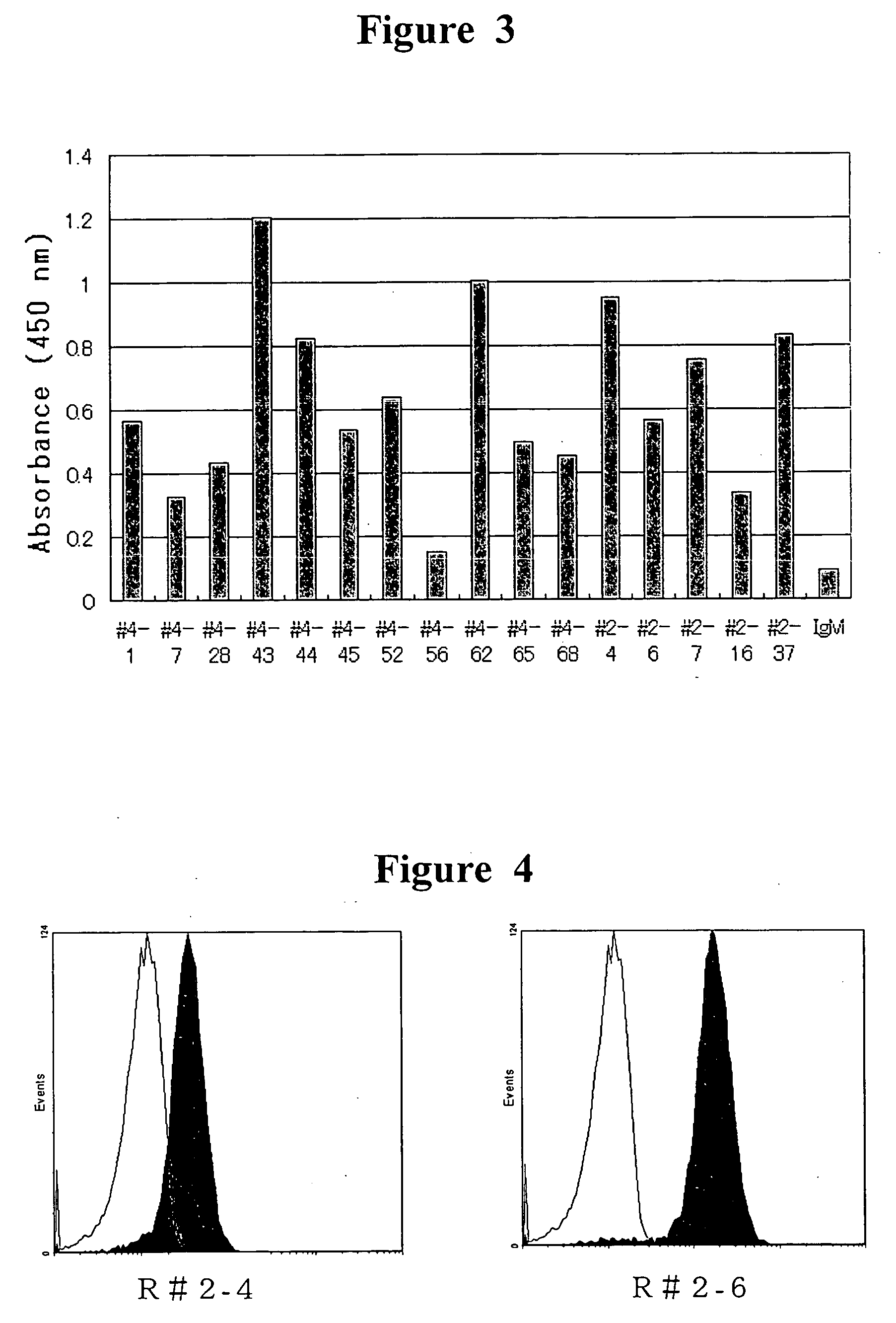Monoclonal antibody against platelet membrane glycoprotein VI
a monoclonal antibody and platelet membrane technology, applied in the field of human platelet membrane glycoprotein vi antibodies, can solve the problems of not being able to apply for immediate drug applications, undetermined industrial production method, and not being able to quickly manufacture drugs, etc., and achieve the effect of convenient manufacturing
- Summary
- Abstract
- Description
- Claims
- Application Information
AI Technical Summary
Benefits of technology
Problems solved by technology
Method used
Image
Examples
example 1
Preparation of a Human Soluble GPVI-Fc
[0120] In order to use as the antigen for in vitro immunization and for screening, a fusion protein consisting of the extracellular domain of human GPVI and Fc fragment of human IgG (GPVI-Fc). In addition, DNA manipulation was according to Molecular Cloning, A Laboratory Manual 3rd ed., Joseph S., et al., Cold Spring Harbor Laboratory Press (2001) unless otherwise noted.
[0121] GPVI-Fc expressing plasmid was prepared by genetic engineering using the following procedure. Using a plasmid pBK-CMV-GPVI-1, in which human GPVI cDNA cloned by Esumi et al. is integrated (Biochem. Biophys. Res. Commun. 2000 Oct. 14; 277(1): 27-36), as a template, sense primer 1 (SEQ ID NO: 33; including a restriction enzyme XbaI recognition sequence at the. 5′ end) and antisense primer 1 (SEQ ID NO: 34; including a restriction enzyme BamH I recognition sequence on the side of the. 5′ end), PCR was performed to get the cDNA encoding a human GPVI extracellular domain (269...
example 2
Preparation of Anti-GPVI Monoclonal Human Antibody Using Human Peripheral Blood Lymphocytes Having an Anti-GPVI Autologous Antibody
[0124] Anti-GPVI monoclonal human antibody was prepared as follows by fusing lymphocytes from a donor who is confirmed to have an autologous antibody to GPVI with myeloma cells. Firstly, by layering 6 ml of heparin added blood aseptically collected from the donor who gave informed consent in writing to Leucosep (Greiner) which added 3 ml of Ficoll-Plus (Amersham Pharmacia Biotech AB) and centrifuging at 1000 g, lymphocyte fraction was recovered. After twice washing the obtained lymphocyte fraction with Dulbecco-PBS (hereinafter, sometimes referred to as D-PBS) by centrifugation at 800 g, the fraction was suspended in Hybridoma-SFM (Invitrogen) containing 10% FCS (fetal bovine serum) to get 7.4×107 cells.
[0125] To the above-mentioned lymphocyte fraction, PHA-L (Sigma), LPS (DIFCO) and the purified GPVI-Fc described in EXAMPLE 1 were added to be 2.5 μg / m...
example 3
Typing of the Anti-GPVI Monoclonal Human Antibody Prepared
[0130] Typing of the antibody obtained in EXAMPLE 2 was done with the Human IgG Subclass Profile ELISA Kit (Zymed Laboratories) and the Western blotting. The ELISA was performed according to the manual, and the diluents of the antibody as the sample were used. For the antibody that cannot be detected with the kit, about one microgram of each sample was isolated on 4-20% SDS-PAGE and transfererred onto PVDF membrane (MILLIPORE) to analyze by Western blotting. That is, after blocking the PVDF membrane, peroxidase-labeled rabbit anti-human IgM antibody (P0322, DAKO) was reacted. After washing, by reacting with ECL reagent (Amersham Pharmacia Biotech AB), the band which reacts with light capture (ATTO) was detected. The results of typing of the obtained anti-GPVI antibody were shown in Table 1.
TABLE 1Results of typingClone numberSub-class(1) When cultivating for 3 days in thepresence of PHA-L and the LPS#2-4IgM / λ#2-6IgM / λ#2-7I...
PUM
| Property | Measurement | Unit |
|---|---|---|
| dissociation constant | aaaaa | aaaaa |
| dissociation constant | aaaaa | aaaaa |
| dissociation constant | aaaaa | aaaaa |
Abstract
Description
Claims
Application Information
 Login to View More
Login to View More - R&D
- Intellectual Property
- Life Sciences
- Materials
- Tech Scout
- Unparalleled Data Quality
- Higher Quality Content
- 60% Fewer Hallucinations
Browse by: Latest US Patents, China's latest patents, Technical Efficacy Thesaurus, Application Domain, Technology Topic, Popular Technical Reports.
© 2025 PatSnap. All rights reserved.Legal|Privacy policy|Modern Slavery Act Transparency Statement|Sitemap|About US| Contact US: help@patsnap.com



